Turkey, officially the Republic of Turkey, is a transcontinental country located mainly on Anatolia in Western Asia, with a portion on the Balkans in Southeast Europe.
Turkey is a regional power and a newly industrialized country, with a geopolitically strategic location. Its economy, which is classified among the emerging and growth-leading economies, is the twentieth-largest in the world by nominal GDP, and the eleventh-largest by PPP. It is a charter member of the United Nations, an early member of NATO, the IMF, and the World Bank, and a founding member of the OECD, OSCE, BSEC, OIC, and G20. After becoming one of the early members of the Council of Europe in 1950, Turkey became an associate member of the EEC in 1963, joined the EU Customs Union in 1995, and started accession negotiations with the European Union in 2005. Turkey has a rich cultural legacy shaped by centuries of history and the influence of the various peoples that have inhabited its territory over several millennia; it is home to 19 UNESCO World Heritage Sites and is among the most visited countries in the world.
Tourism in Turkey has increased almost every year in the 21st century, and is an important part of the economy. The Turkish Ministry of Culture and Tourism currently promotes Turkish tourism under the project Turkey Home. Turkey is one of the world’s top ten destination countries, with the highest percentage of foreign visitors arriving from Europe; specially Germany and Russia in recent years. In 2019, Turkey ranked sixth in the world in terms of the number of international tourist arrivals behind Italy, with 51.2 million foreign tourists visiting the country. Turkey has 19 UNESCO World Heritage Sites, and 84 World Heritage Sites in tentative list. Turkey is home to 519 Blue Flag beaches, which makes it in the third place in the world.
Istanbul is the tenth most visited city in the world with 13,433,000 annual visitors as of 2018 and with the annual growth rate of 25.2%. Istanbul expects 1 million tourists from cruise companies after the renovation of its cruise port, also known as Galataport in Karaköy district.
Antalya is the second most visited city in Turkey, with over 9 million tourists in 2021.Lycian Way is a 500 km marked long-distance trail in southwestern Turkey that starts from Fethiye and ends in Antalya.
1.Hagia Sophia (Aya Sofya) Mosque
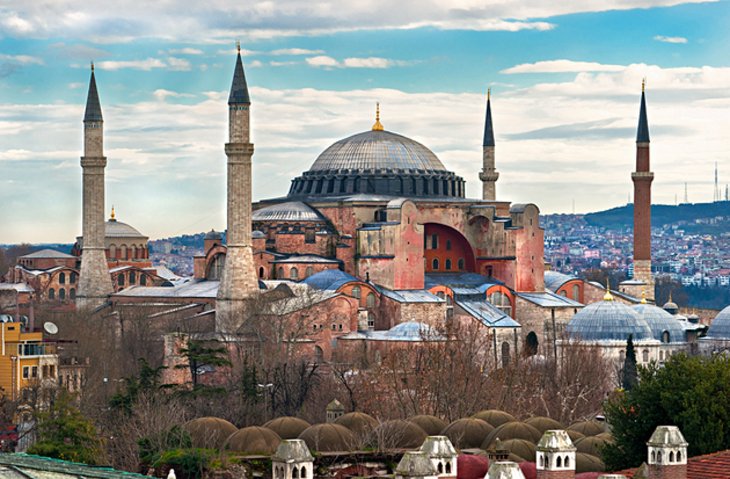
Hagia Sophia, officially known as the Holy Hagia Sophia Grand Mosque and formerly as the Church of Holy Wisdom, is a Late Antique place of worship in Istanbul, designed by the Greek geometers Isidore of Miletus and Anthemius of Tralles.
The religious and spiritual centre of the Eastern Orthodox Church for nearly one thousand years, the church was dedicated to the Holy Wisdom. It was where the excommunication of Patriarch Michael I Cerularius was officially delivered by Humbert of Silva Candida, the envoy of Pope Leo IX in 1054, an act considered the start of the East–West Schism. In 1204, it was converted during the Fourth Crusade into a Catholic cathedral under the Latin Empire, before being returned to the Eastern Orthodox Church upon the restoration of the Byzantine Empire in 1261. The doge of Venice who led the Fourth Crusade and the 1204 Sack of Constantinople, Enrico Dandolo, was buried in the church.
After the Fall of Constantinople to the Ottoman Empire in 1453, it was converted to a mosque by Mehmed the Conqueror and became the principal mosque of Istanbul until the 1616 construction of the Sultan Ahmed Mosque. Upon its conversion, the bells, altar, iconostasis, ambo, and baptistery were removed, while iconography, such as the mosaic depictions of Jesus, Mary, Christian saints and angels were removed or plastered over. Islamic architectural additions included four minarets, a minbar and a mihrab. The Byzantine architecture of the Hagia Sophia served as inspiration for many other religious buildings including the Hagia Sophia in Thessaloniki, Panagia Ekatontapiliani, the Şehzade Mosque, the Süleymaniye Mosque, the Rüstem Pasha Mosque and the Kılıç Ali Pasha Complex. The patriarchate moved to the Church of the Holy Apostles, which became the city’s cathedral.
The complex remained a mosque until 1931, when it was closed to the public for four years. It was re-opened in 1935 as a museum under the secular Republic of Turkey, and the building was Turkey’s most visited tourist attraction in 2015 and 2019.
2.Cappadocia
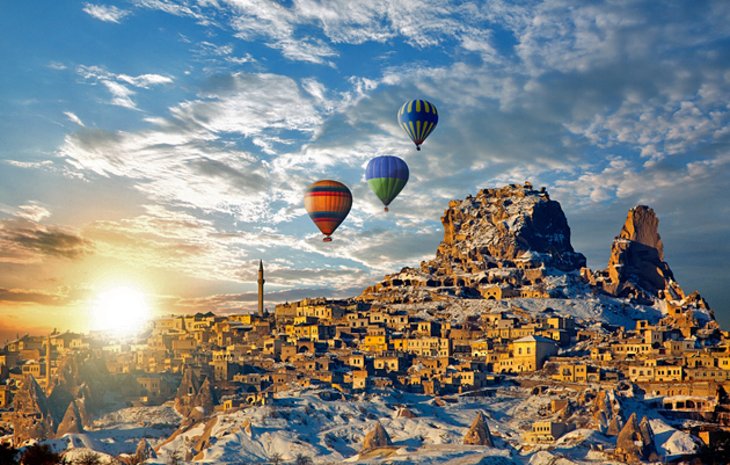
Cappadocia, a semi-arid region in central Turkey, is known for its distinctive “fairy chimneys,” tall, cone-shaped rock formations clustered in Monks Valley, Göreme and elsewhere. Other notables sites include Bronze Age homes carved into valley walls by troglodytes (cave dwellers) and later used as refuges by early Christians. The 100m-deep Ihlara Canyon houses numerous rock-face churches.
According to Herodotus, in the time of the Ionian Revolt (499 BC), the Cappadocians were reported as occupying a region from Mount Taurus to the vicinity of the Euxine (Black Sea). Cappadocia, in this sense, was bounded in the south by the chain of the Taurus Mountains that separate it from Cilicia, to the east by the upper Euphrates, to the north by Pontus, and to the west by Lycaonia and eastern Galatia.
The name, traditionally used in Christian sources throughout history, continues in use as an international tourism concept to define a region of exceptional natural wonders, in particular characterized by fairy chimneys and a unique historical and cultural heritage.
The area is a popular tourist destination, as it has many areas with unique geological, historic, and cultural features.
Touristic Cappadocia includes 4 cities: Nevşehir, Kayseri, Aksaray and Niğde.
The region is located southwest of the major city Kayseri, which has airline and railway service to Ankara and Istanbul and other cities.
The most important towns and destinations in Cappadocia are Ürgüp, Göreme, Ihlara Valley, Selime, Guzelyurt, Uçhisar, Avanos and Zelve. Among the most visited underground cities are Derinkuyu, Kaymakli, Gaziemir and Ozkonak. The best historic mansions and cave houses for tourist stays are in Ürgüp, Göreme, Guzelyurt and Uçhisar.
Hot-air ballooning is very popular in Cappadocia and is available in Göreme. Trekking is enjoyed in Ihlara Valley, Monastery Valley (Guzelyurt), Ürgüp and Göreme.
3.Topkapı Palace
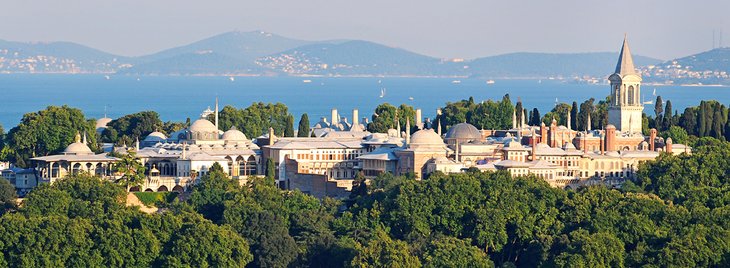
The name of the palace was Saray-i Cedid-i Amire (Ottoman: سراى جديد عامره, Imperial New Palace) until the 18th century. The palace received its current name during Mahmud I’s reign; when Topkapusu Sâhil Sarâyı, the seaside palace, was destroyed in a fire its name was transferred to the Palace. In Turkish the current name of the palace, Topkapı, means Cannon Gate.It was given the name Topkapı, meaning Cannon Gate, in the 19th century. The complex expanded over the centuries, with major renovations after the 1509 earthquake and the 1665 fire. The palace complex consists of four main courtyards and many smaller buildings. Female members of the Sultan’s family lived in the harem, and leading state officials, including the Grand Vizier, held meetings in the Imperial Council building.
the Spoonmaker’s Diamond and the Topkapi Dagger are on display. The museum collection also includes Ottoman clothing, weapons, armor, miniatures, religious relics, and illuminated manuscripts such as the Topkapi manuscript. Officials of the ministry as well as armed guards of the Turkish military guard the complex. The Topkapı Palace forms a part the Historic Areas of Istanbul, a group of sites in Istanbul that UNESCO recognised as a World Heritage Site in 1985.
It closely resembles the Yerevan Kiosk. The three doors to the porch are located between the sofas. The façade is covered with marble, strips of porphyry and verd antique. The marble panelling of the portico is executed in Cairene Mamluk style. The interior is an example of an ideal Ottoman room. The recessed shelves and cupboards are decorated with early 16th-century green, yellow and blue tiles. The blue-and-white tiles on the walls are copies of the tiles of the Circumcision Room, right across the terrace. With its tiles dating to the 17th century, mother-of-pearl, tortoise-shell decorated cupboard and window panels, this pavilion is one of the last examples of the classical palace architecture.
4.Antalya
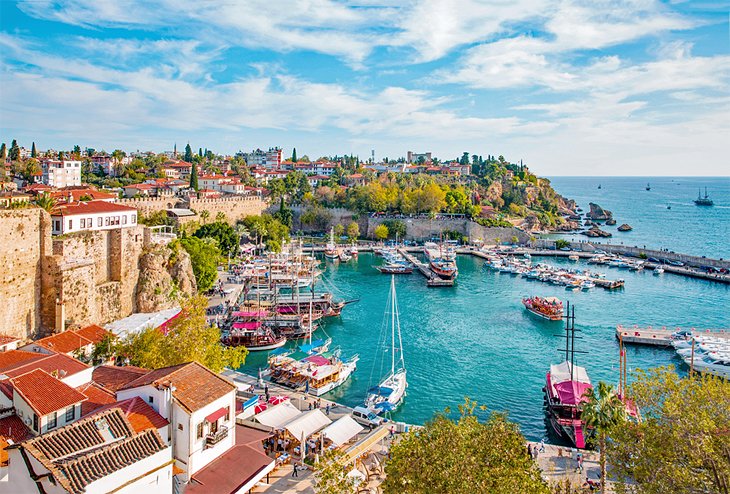
Antalya is a Turkish resort city with a yacht-filled Old Harbor and beaches flanked by large hotels. It’s a gateway to Turkey’s southern Mediterranean region, known as the Turquoise Coast for its blue waters. Remnants remain from Antalya’s time as a major Roman port. These include Hadrian’s Gate, built to honor the Roman emperor’s visit in 130 A.D and 2nd-century Hidirlik Tower, with harbor views.
The city that is now Antalya was first settled around 200 BC by the Attalid dynasty of Pergamon, which was soon subdued by the Romans. Roman rule saw Antalya thrive, including the construction of several new monuments, such as Hadrian’s Gate, and the proliferation of neighboring cities. The city has changed hands several times, including to the Seljuk Sultanate in 1207 and an expanding Ottoman Empire in 1391. Ottoman rule brought relative peace and stability for the next five hundred years. The city was occupied by Italy for three years in the aftermath of World War I, but was recaptured by a newly independent Turkey in the War of Independence.
Antalya is Turkey’s biggest international sea resort, located on the Turkish Riviera. Large-scale development and governmental funding has promoted tourism. A record 13.6 million tourists passed through the city in 2019.
The 13th-century Seljuk mosque at Attalea, now in ruins, had been a Christian Byzantine basilica from the 7th century. The Great Mosque had also been a Christian basilica and the Kesik Minare Mosque had been the 5th-century Christian Church of the Panaghia or Virgin and was decorated with finely carved marble. The archaeological museum at Attalea houses some sarcophagi and mosaics from nearby Perga and a casket of bones reputed to be those of St. Nicholas, the bishop of Myra, further down the Turquoise coast.
Attalea was a major city in the Byzantine Empire. It was the capital of the Byzantine Theme of the Cibyrrhaeots, which occupied the southern coasts of Anatolia. According to the research of Speros Vryonis, it was the major naval station on the southern Anatolian coast, a major commercial center, and the most convenient harbor between the Aegean Sea and Cyprus and points further east. Besides the local merchants, “one could expect to see Armenians, Saracens, Jews, and Italians.
5.Cruising the Mediterranean
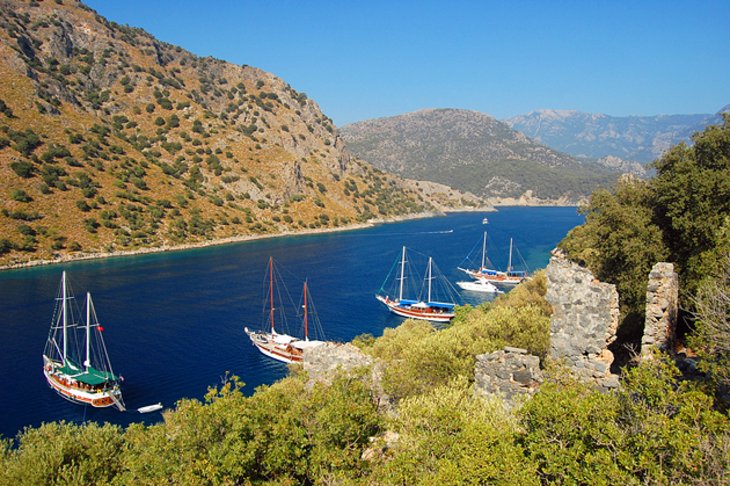
Whether you’re exploring the vibrant streets of Barcelona or immersing yourself in Istanbul’s historic sites, the Mediterranean region offers unlimited adventures. And what better way to see it all than on board a cruise ship? To help determine which cruise lines offer the best Mediterranean experience, U.S. News used a methodology factoring in the number and variety of itineraries in the region and the line’s approval rating among experts and travelers. Plus, considering the region’s immense popularity as a cruise destination, you’ll likely find cruise deals to this region year-round.
Turkey’s Mediterranean coastline has ruins galore and many things to do, but for many people, it’s all about soaking up the sun while enjoying the gorgeous coastal views.
Cruising on a yacht is the number one activity for visitors to Bodrum and Fethiye for good reason. The steep forest-clad slopes, hidden coves sporting tiny white-sand beaches, and hundreds of scattered islands are the perfect place for exploring by sea. Even diehard landlubbers will be impressed.
One of the most famous trips is known as the Blue Cruise and travels from Fethiye south down the coast until disembarking near Olympus, home to the famous natural phenomenon of the Chimaera.
6.Mount Nemrut
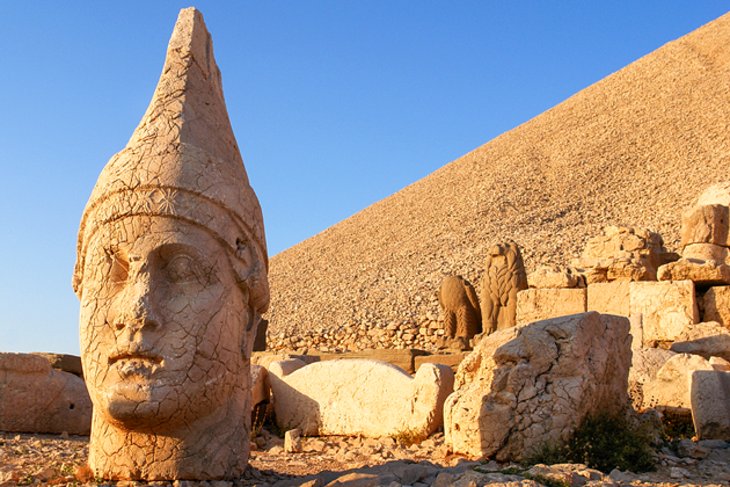
The mountain lies 40 km (25 mi) north of Kahta, near Adıyaman. In 62 BC, King Antiochus I Theos of Commagene built on the mountain top a tomb-sanctuary flanked by huge statues 8–9-metre high (26–30 ft) of himself, two lions, two eagles, and various composite Greek and Iranian gods, such as Heracles-Artagnes-Ares, Zeus-Oromasdes, and Apollo-Mithras-Helios-Hermes. When constructing this pantheon, Antiochus drew heavily from Parthian and Armenian traditions in order to reinvigorate the religion of his ancestral dynasty. The statues were once seated, with names of each god inscribed on them. At some point the heads of the statues were removed from their bodies, and they are now scattered throughout the site.
The pattern of damage to the heads (notably to noses) suggests that they were deliberately damaged as a result of iconoclasm. The statues have not been restored to their original places. The site also preserves stone slabs with bas-relief figures that are thought to have formed a large frieze. These slabs, or stelae, depict Antiochus’ Greek and Persian ancestors.
The western terrace contains a large slab with a lion, showing an arrangement of stars and the planets Jupiter, Mercury, and Mars. The composition was taken to be a chart of the sky on 7 July 62 BCE. This may be an indication of when construction began on this monument. The eastern portion is well preserved, being composed of several layers of rock, and a path following the base of the mountain is evidence of a walled passageway linking the eastern and western terraces. Possible uses for this site are thought to have included religious ceremonies, owing to the astronomical and religious nature of the monument.
7.Ölüdeniz

Ölüdeniz is a resort village on the southwest coast of Turkey. It’s known for the blue lagoon of Ölüdeniz Tabiat Parkı and the wide, white Belcekız Beach. Overlooking the village is Babadağ mountain from where paragliders take to the skies. The Lycian Way is a long-distance marked footpath starting in Ölüdeniz, and has coastal views. To the south, Butterfly Valley is a nature reserve with a secluded bay.
YY Ölüdeniz is also famous for its paragliding opportunities. It is regarded as one of the best places in the world to paraglide due to its unique panoramic views, stable weather conditions, and Mount Babadağ’s exceptional height.[3][4] Babadag (Father Mountain) towering above Ölüdeniz on the Southwest coast of Turkey is a geological marvel that just happens to make for incredible thermals and ideal conditions for paragliding flight. Oludeniz is reputedly the best site in Europe, if not the world, to fly paragliders cross-country in both solo and tandem modes.
Ölüdeniz offer a variety of diving opportunities with regard to its crystal clear waters and rich underwater caves and fauna. Scuba diving is the most popular underwater activity. Local diving agencies provide courses and required scuba diving licences. Snorkelling is another diving activity and many sites are very suitable for snorkelling.









